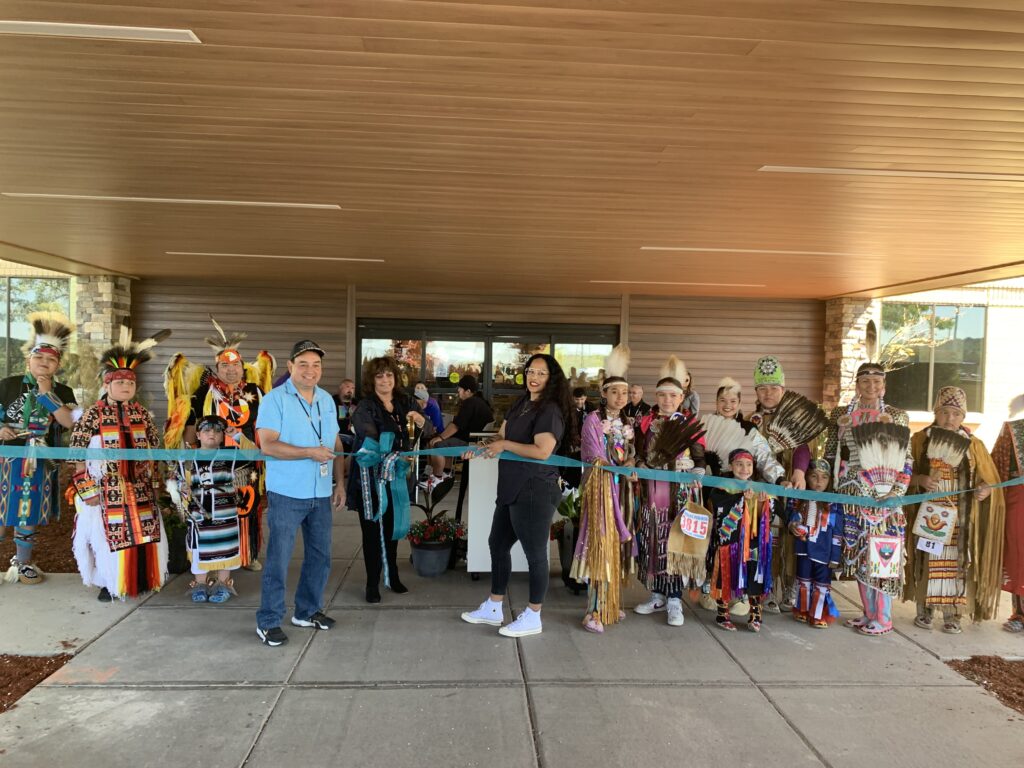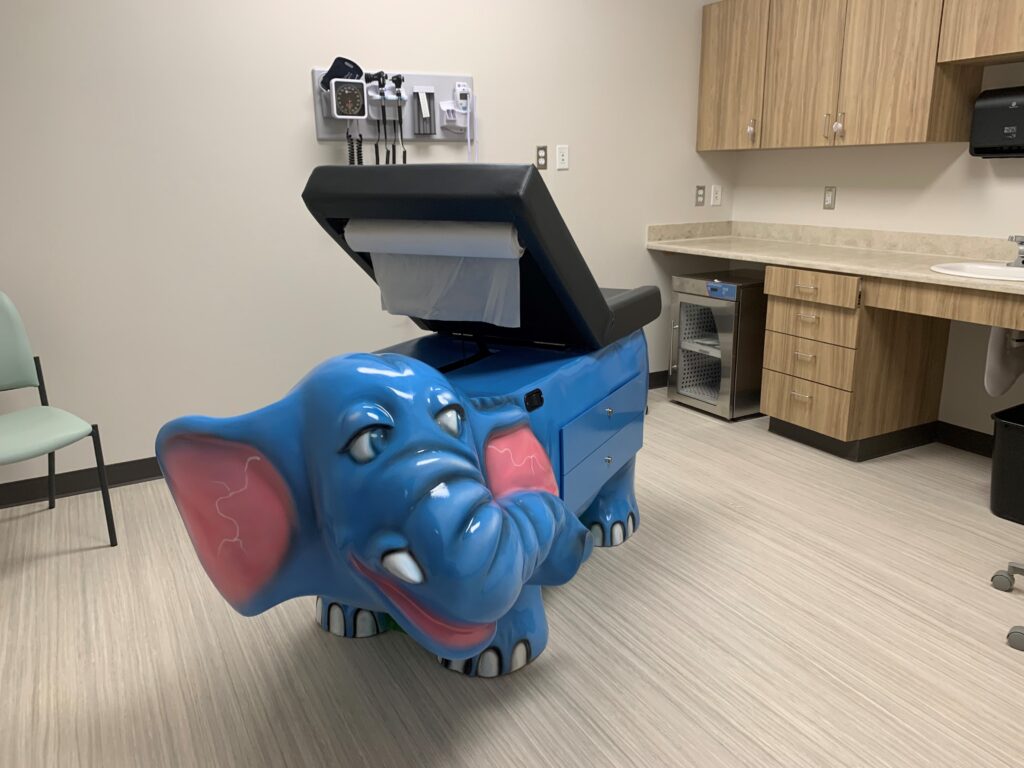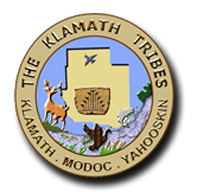FOR IMMEDIATE RELEASE
Date: May 23, 2023
Contact: Ken Smith, Public Relations Director
kenneth.smith@klamathtribes.com; 541-783-2219 ext. 147
Download .pdf Press Release
Grand Opening of Klamath Tribal Health Center Showcases State-of-the-Art Medical and Dental Facilities
CHILOQUIN, Ore. – A grand opening of the Klamath Tribal Health & Family Services (KTHFS) Center was held Friday, May 19, from 10 a.m. to 2 p.m. Tribal members were able to tour the state-of-the-art medical, dental and pharmaceutical facilities. KTHFS is also home to the Youth & Family Guidance Center (Behavioral Health programs). The 43,500 square-foot building is located on the top of a hill at 6000 New Way in Klamath Falls on 22 acres owned by the tribe and easily accessible from Highway 97 North. This new center is considered a satellite clinic to the tribes’ Chiloquin Wellness Center.
The event began with opening remarks by guest speakers, including Klamath Tribes Chairman Clayton Dumont Jr.
“I think that days like today, when we can showcase our accomplishments, are important for another reason,” Dumont said. “It’s a chance for us to see beyond the horizon of the day. Think about what it was like before, where we’ve been and where we’re trying to get to. Compare where we were to this, to this beautiful, beautiful facility. Now I know that every tribal member here knows, and those of you who know us and care about us, recognize that the Klamath Tribes continue to experience more than our fair share of pain, of grief, and of tragedy. It can be overwhelming. And I don’t want to try to recite all the names, and all the families, who have dealt with these struggles in the last months or recent years.”
Dumont cited a display of the old historic treaty of the Klamath Tribes that can be seen when entering the building, and thanked and recognized the family of Tyler Bates who donated it. Tyler passed away at a young age, and a beautiful plaque and picture of Tyler that his family dedicated in his honor is next to the treaty,
“Tyler, like too many of our young people, we lost at way too young of an age, and under circumstances that should have never happened,” said Dumont. He continued after an emotional pause, “So, as I was saying, I think that occasions like this are a chance to reflect, to try to escape that grief, that fog, for a moment, to think about the advances that we’ve made. We still have a lot of work to do, and nobody should try to minimize that. But if you’re old enough to think back, to think back to the time of termination; my living memories only go back as far as the mid to late 1960s, but we lost everything. We really had nothing to hold on to. Except for our families and ourselves. And those days, were, for many, beyond tragic.”
Dumont said his own adverse childhood experiences were not unique among the tribal members, and overcoming these experiences is hard and requires a lot of work. “But that pain, and that collective struggle, that all of us are engaged in, is what makes this day, and this place, so amazing,” he said.
After opening remarks, the drum, Northern Eagle, brought in the dancers, followed by a ribbon-cutting ceremony. Then the tribal member and guests entered the building, enjoyed lunch, dessert and were given gift bags. Afterwards, tours of the facilities were conducted by KTHFS staff.
Klamath Tribal Health & Family Services Health General Manager Chanda Yates addressed the importance of the center’s self-sufficiency. “What’s really important to emphasize is that this facility is 100 percent paid for by the Klamath Tribes, reinvesting in healthcare for their people.”
The Klamath Tribes General Council approved $17 million for the project using third party revenue, she said, generated by billing for the services offered. The third-party dollars were re-invested to the Klamath Tribes health care programs and services. Currently, the behavioral health facility is fully open with its full scope of work for mental health services and substance abuse outpatient programming.
The dental facility had a soft opening with existing staff providing dental emergencies. Existing staff from pharmacy and medical services will rotate between the tribes’ Chiloquin health center and KTHFS. The pharmacy is providing point-of-dispensing and allowing tribal members to pick up their medication in Klamath Falls instead of driving to Chiloquin. “Eventually, when we hire additional staff, they’ll have a full pharmacy team down here dispensing meds,” Yates said.
Yates said they are in the process of recruiting a full dental team, starting with another dental hygienist. She said her goal, in partnership with the center’s Chief of the Dental Department, Dr. Tom Barrett, is to have the remainder of the dental staff in place by the end of the year.
As for the medical facility, Yates said it will take longer to staff. “We have all of the providers that we need to open at 6000 New Way,” she said. “We have some existing vacancies we are in the process of recruiting for, such as a family nurse practitioner and medical doctor. So, our hope is that we’ll get those filled. We’re using a professional recruitment firm to help us. With the nation-wide shortage of healthcare professionals, it’s very difficult for rural Oregon to find and secure physicians that want to come and live and work in our area. I’ve been here since March of 2022, and those two positions have been vacant since that time.”
Yates said the medical facility will be open for full-service at the end of July. They will be bringing one of their existing primary care providers down from Chiloquin and have a rotating staff, with one full team serving the population. “What we’re going to run into is access issues,” she said. “One primary care team could probably serve 750 to 1,000 patients. We have a feeling that Klamath Falls is going to have a higher demand. Right now, our addresses for all of our patients show that two-thirds of the population live in Klamath Falls, and they likely will choose this facility. So, we will be monitoring our data closely.”
Yates said their recruitment efforts are going well, but it will be a slow phase-in, and that is how they designed it, in order for the facility to be sustainable in the long-term. “We want to slowly introduce this new location to the community so that it’s widely accepted and used.”
In addition to the national recruitment service, Yates said they are partnering with Indian Health Service which offers a wide range of recruitment opportunities, and, if necessary, are looking to bring in Commissioned Corp Officers of the U.S. Public Health Service to provide services, and they hope to potentially partner with Sky Lakes Medical Center to recruit professionals.
A year from now, they will probably still be in phase II of operations, said Yates, which includes opening up the full scope of work for the facility. She added that with her 30 years of experience in the healthcare field, her best guess is that the health center may not be able to keep up with the demand and will likely still be struggling to recruit providers. “We have to open in a way that’s sustainable long-term for this tribe, so that we can continue to afford the services, and pay for the staff, and then bill for the services we offer.”
On a tour of the dental facility, top-of-the-line equipment was featured in every room, as is the case for all the facilities at the center, including a panoramic 3D cone beam CT scan, all digital X-rays, seven dental exam rooms, silent, electric dental drills, and comfortable chairs.
One of the center’s dentist, Dr. Jeffrey Guelinas, was enthusiastic about the state-of-the-art equipment they have, such as silent drills for fillings and crowns. “These handpieces are super quiet, you just hear the spray of the water and air, and you don’t have that horrible whine everyone always complains about,” he said.
Dr. Guelinas said they may begin more services beyond emergency care at the end of the summer as they get more employees.
Next was a tour of the medical facility with Brandon Tupper, Patient Registration Manager. He pointed out the roomy three triage rooms, a dietician consultant room, a pediatric room with a cartoon-designed elephant exam table to ease the anxiety of the young patients, and nine spacious exam rooms. “The space we have here is so much more than the ones we have in Chiloquin,” Tupper said. And he touted the state-of-the-art equipment. “It’s really going to be amazing for our tribal members, and we are excited for when we get rockin’ and rollin’.” As we walked through the spacious nurses’ station, he pointed out that it is three times the size of the one in the Chiloquin health center.
In addition to the medical facility services, Tupper said they offer community health services assisting home-bound patients with a team of four full-time staff members. Concluding the tour, he showed the tenth exam room for patients in need of isolation, and finally a large lab room.
Dr. Sara Folden, the Klamath Tribal Health Center Chief Medical Officer, who was hired last October, expressed her enthusiasm for the size and interior aesthetics of the building, and its growth potential for services offered to the tribe. “It’s just beautiful,” she said. “The space that we have, lots of room to grow, which will be wonderful for the tribe.”
Folden said they are actively recruiting and trying to bring in more employees. She said there are medical students arriving, both a medical student and family nurse practitioner. “Ideally, I’d like to grow our own,” Folden said. “I’d like to start with the junior high kids, and get in the school and let them know what we do, and find the people who are motivated and want to move in a medical direction and mentor them.” She added that they have good relations with the Oregon Institute of Technology, Sky Lakes, and Oregon State University to assist in their recruitment efforts.
The last tour was of the spacious pharmaceutical facility, conducted by the Pharmacy Director, Tim Langford, another very enthusiastic staff member. Touring the backroom where the medication is stored and records kept, he described the use of a robotic system, also used in Chiloquin, that has an electronic eye and counts each tablet as it drops into the vile, then caps the medication and stores it. He said the robotic system accounts for 60 percent of the medication filled at the pharmacy and does so with high efficiency and accuracy. The pharmacy also employs two couriers who deliver medication to tribal members.
The pharmacy is twice the size of Chiloquin’s, Langford said, with much more medication storage shelves. “You can see they’re like library shelves,” he said. “Hopefully, they’ll make sure we have medicine, because sometimes we run out, especially over the last three years. Drug chain supply is a major issue. Just like getting groceries at the grocery store, and you can’t get whatever sometimes. And that’s affected medication, and so you have to stock more medicine to prevent that from happening.”
Langford said the goal is to have a full-staff of board-certified clinical pharmacists. He added that all the tribal centers’ pharmacists currently working are board-certified. “Our goal is to do really good clinical pharmacy,” he said.
KTHFS is working on opening some level of pharmacy services at 6000 New Way. The pharmacy is being set up with the physical aspects, technology, and software needed to run a pharmacy. Once physical, technology, and software are setup and they have enough staff, patients will be able to request medications filled in Chiloquin and then shipped to the 6000 New Way location for pickup. Later, as the pharmacy becomes fully staffed, the 6000 New Way pharmacy will open as a pharmacy that fills medications. Based on their medication volume, and per prescription volume, Langford added, they are able to do more with better work flow and technology, efficiency of the robotic system, and efficiency overall.

A ribbon-cutting ceremony kicks off the grand opening of the Klamath Tribal Health & Family Services Center May 19. (Photo by Ken Smith/Klamath Tribes. Image is available for media use.)

A pediatric exam table in the Klamath Tribal Health & Family Services Center. (Photo by Ken Smith/ Klamath Tribes. Image available for media use.)
About The Klamath Tribes
The Klamath Tribes primary mission is to “protect, preserve and enhance the spiritual, cultural and physical values and resources of the Klamath, Modoc and Yahooskin Peoples by maintaining the customs of our ancestors.” The heart of Tribal life is centered in the area of Chiloquin, Oregon and includes 12 Departments, Health Clinic, Childcare Center, Tribal Court, goos oLgi gowa Center, Research StaLon, and three tribal enterprises. The Klamath Tribes’ 12 departments facilitate service delivery to mulLple aspects of tribal life, including health and fitness, educaLon, economic development, social services, cultural preservaLon, natural resource protecLon and more. For more informaLon visit hPps://klamathtribes.org/.





